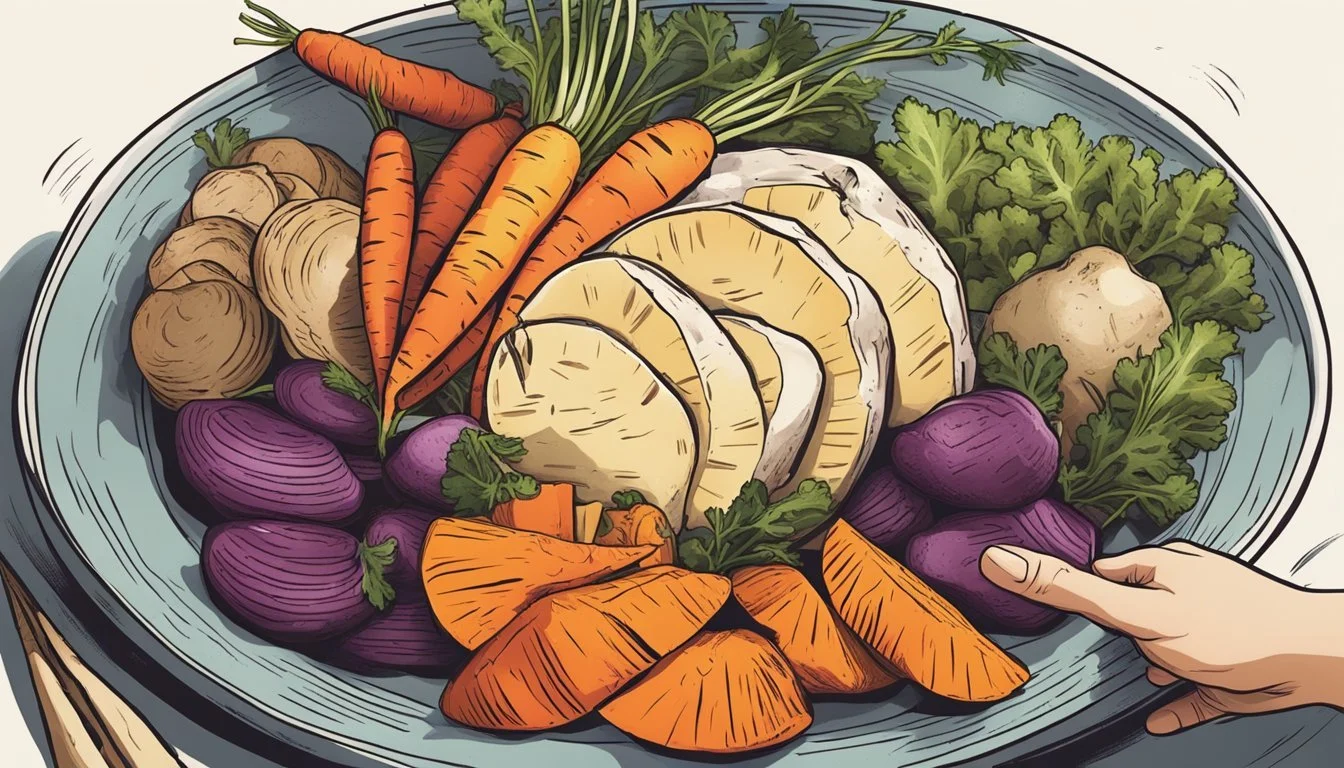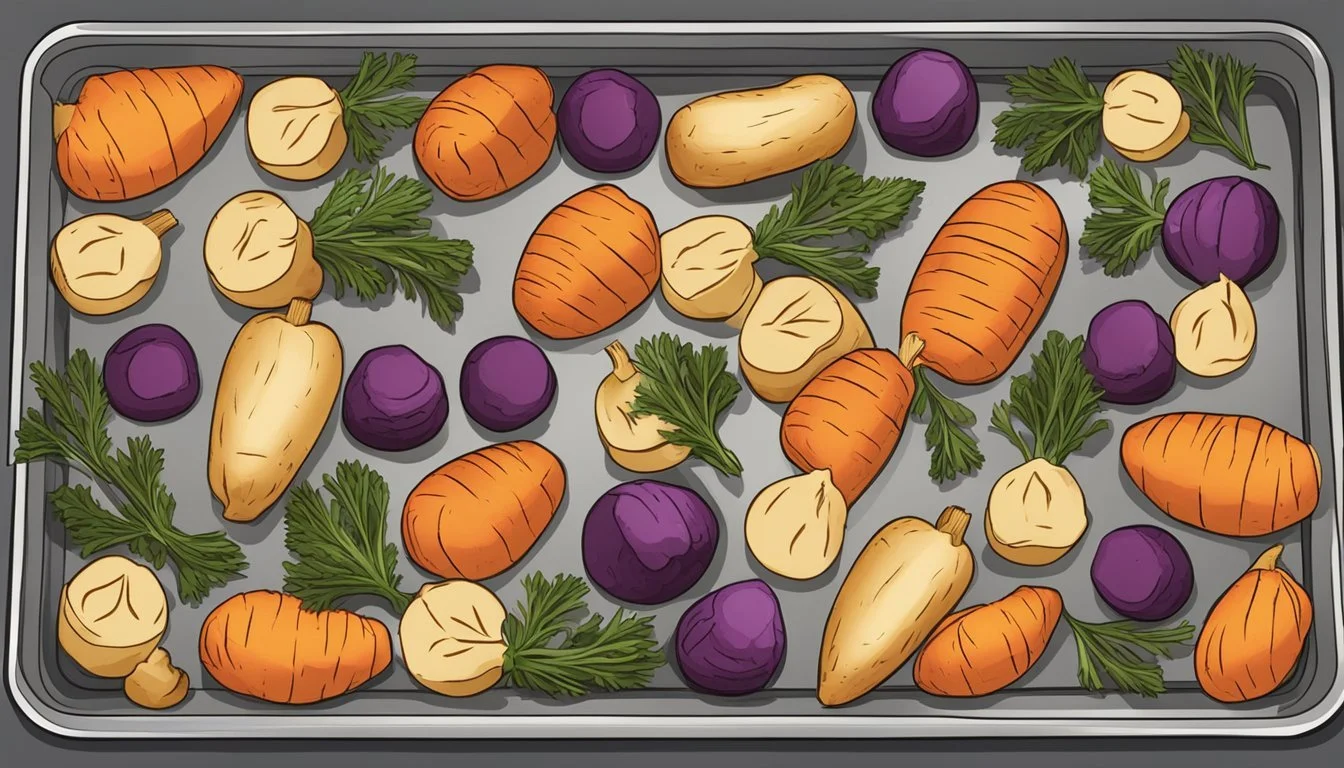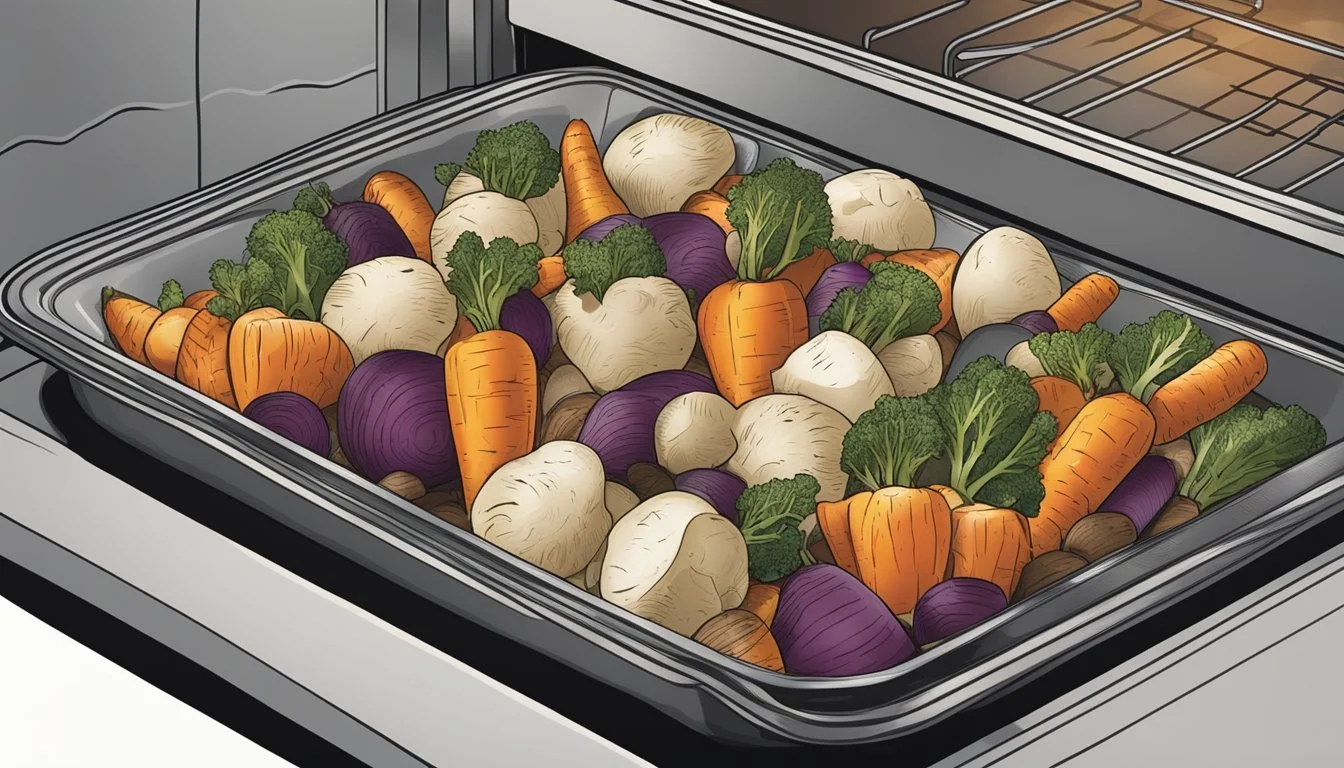How to Reheat Gluten-Free Roasted Root Vegetables for Optimal Flavor
Roasted root vegetables are a staple in many kitchens. They're versatile, easy to prepare, and suitable for a gluten-free diet. Often, there are leftovers, and knowing the best way to reheat them ensures that flavor and texture are preserved.
When it comes to reheating these nutritious side dishes, the oven is your best friend. To revive the hearty texture and savory taste, preheat your oven to 350°F (175°C) and warm the vegetables for 10-15 minutes. This method maintains the crisp outer layer while keeping the inside tender.
Microwaving is another quick option if you're in a hurry. Place the vegetables in a microwavable container, cover loosely, and heat for 1-2 minutes until piping hot. This technique works well but can slightly soften the vegetables more than baking.
Health Benefits of Roasted Root Vegetables
Roasted root vegetables offer numerous health benefits, including nutrient density, digestive support, and essential vitamins and minerals. They can serve as a nutritious and tasty component of a balanced diet.
Nutritional Profile
Roasted root vegetables are packed with nutrients. They tend to be low in calories but rich in essential vitamins and minerals. For example, a mix of carrots, sweet potatoes, and parsnips provides an excellent balance of carbohydrates, proteins, and healthy fats.
A typical serving is low in sugar and moderately high in fiber, making them an excellent choice for those monitoring their sugar intake. The presence of complex carbohydrates supports sustained energy release, which is beneficial for daily activities.
Dietary Fiber and Digestion
Dietary fiber plays a key role in digestion, and roasted root vegetables are a fantastic source. The fiber content helps regulate the digestive system, preventing constipation and promoting healthy gut bacteria.
Sweet potatoes and carrots are particularly high in fiber, which aids in maintaining a feeling of fullness. This can help with weight management by reducing the likelihood of overeating. Proper digestion also ensures better nutrient absorption, enhancing overall nutritional benefits.
Vitamins and Minerals
Roasted root vegetables are rich in essential vitamins and minerals. They often contain high levels of vitamin A, important for immune function and eye health. Carrots are especially rich in beta-carotene, which the body converts to vitamin A.
Vitamin C is another key nutrient found in many root vegetables, supporting the immune system and promoting healthy skin. Minerals such as potassium, calcium, and iron are also abundant. Potassium helps regulate blood pressure, while iron is crucial for oxygen transport in the blood.
Including a variety of root vegetables ensures a broad intake of these valuable vitamins and minerals, directly contributing to improved health and wellbeing.
Preparing Root Vegetables for Roasting
Proper preparation of root vegetables ensures even roasting and rich flavor. This process involves careful selection, precise preparation, and optimal roasting techniques.
Selecting the Right Vegetables
Choosing fresh and firm root vegetables is essential. Popular choices include carrots, parsnips, potatoes, sweet potatoes, beets, onions, butternut squash, turnips, and rutabagas. These vegetables have a natural sweetness that caramelizes beautifully in the oven.
For a balanced flavor profile, it’s wise to mix a variety of these vegetables. Each type brings a unique texture and taste. Ensure they are free of blemishes or soft spots, as this can affect the overall quality of the dish.
Preparation and Seasoning
Wash and peel the vegetables as needed. Carrots, parsnips, and potatoes may need peeling, while thinner-skinned varieties like beets can often be roasted with their skins intact. Cut vegetables into uniform pieces to ensure even cooking.
Seasoning is crucial. Toss the vegetables in olive oil, then sprinkle with salt and pepper. To elevate the flavor, add garlic, thyme, rosemary, or other fresh or dried herbs. Coating the vegetables thoroughly ensures each piece is well-seasoned.
Roasting to Perfection
Preheat the oven to 400ºF (200ºC). Line a baking sheet with parchment paper for easy cleanup. Spread the vegetables out in a single layer to avoid overcrowding, which can lead to uneven cooking.
Roast the vegetables for about 25-35 minutes, shaking the pan halfway through to ensure all sides are evenly browned. Check for tenderness by piercing with a fork. If needed, roast for an additional 10-15 minutes until caramelized and golden brown.
This method creates perfectly roasted vegetables that are tender inside and crispy outside.
How to Reheat Roasted Root Vegetables
Reheating roasted root vegetables correctly can restore their crispiness and flavor. The best methods include using an oven, a skillet, or a microwave, each offering different advantages.
Reheating in the Oven
For the best texture, use the oven to reheat roasted root vegetables. Preheat your oven to 400ºF (200ºC). Lay the vegetables on a baking sheet in a single layer.
Optionally, drizzle with olive oil if the vegetables aren't too oily already. Bake for 4-6 minutes, shaking the tray halfway through. This method ensures even heating and crispiness, retaining the delicious roasted flavor.
Using a Skillet
A skillet offers a quick way to reheat your vegetables with a crispy finish. Heat 1 tablespoon of olive oil in a skillet over medium heat. Once the oil is warm, add an even layer of vegetables.
Let them cook for about 5 minutes, flipping them halfway through. This method is particularly effective for small batches and adds a bit of extra flavor from the oil.
Microwave Heating Tips
Although not the best for crispiness, the microwave offers convenience. Spread the roasted vegetables on a microwave-safe plate in a single layer. Cover with a microwave-safe lid or damp paper towel to retain moisture.
Heat on medium power for 1-2 minutes, stopping to check and stir halfway through to avoid uneven reheating. This method is best for those in a hurry who need a fast solution.
Storing Leftover Roasted Vegetables
Proper storage of leftover roasted vegetables ensures they remain delicious and safe to eat. There are two main methods: refrigeration and freezing.
Refrigeration Best Practices
Let the roasted vegetables cool down to room temperature, around 30 minutes. Use airtight containers to store them, as this helps maintain their flavor and prevents odors from other foods in the fridge.
Place the vegetables in the fridge within two hours of roasting to reduce the risk of bacterial growth. For the best taste, consume the leftovers within 2-3 days.
If you're concerned about maintaining the texture of root vegetables like sweet potatoes or carrots, consider using foil to cover the container. This can help reduce moisture loss, ensuring they stay sweet and delicious.
Freezing and Thawing
Freezing is ideal for longer storage. Spread the cooled roasted vegetables in a single layer on a parchment paper-lined baking sheet.
Freeze the vegetables overnight to prevent them from sticking together. Once frozen, transfer them to a freezer bag or an airtight container. Label the container with the date to keep track of storage time.
For best results, use the frozen vegetables within six months to avoid freezer burn. When ready to eat, thaw them in the fridge overnight. You can also use a microwave or place them directly in a preheated oven for quicker thawing.
Proper freezing and thawing ensure that your leftovers retain their delicious flavors and textures.
Enhancing Your Meal
Reheating gluten-free roasted root vegetables opens up a range of delicious possibilities. They can serve as a versatile base for various meals, offering both nutrition and taste.
Pairings and Combinations
Roasted root vegetables can integrate seamlessly into many dishes. Grain bowls are a popular option, combining elements like quinoa, rice, or farro with the vegetables for a well-rounded meal. Add a protein such as grilled chicken, seared steak, or roasted turkey to enhance the dish further.
For a vegetarian or vegan twist, use chickpeas, lentils, or tofu. Salads also benefit from the addition of reheated vegetables. Mixing greens and a light vinaigrette with warm vegetables adds depth and texture. As a side dish, they perfectly complement a variety of mains, from holiday meals to everyday dinners.
Creative Uses for Leftovers
Leftover roasted root vegetables offer numerous culinary opportunities. One simple yet delicious option is incorporating them into a grain bowl. Layer the vegetables with grains, fresh greens, and a drizzle of dressing for a balanced and hearty lunch.
Another idea is using them in a salad, adding crunch with nuts or seeds and zing with a citrus-based dressing. These leftovers can also be a standout side dish for a roasted chicken or steak dinner. For more inventive uses, consider blending them into soups or purees, creating a flavorful base for stews.
Leveraging leftovers creatively can elevate any meal, providing both convenience and taste.
Recipe Variations and Ideas
Different flavor profiles and combinations can bring new life to gluten-free roasted root vegetables. Experimenting with seasonings and incorporating a variety of vegetables can enhance both taste and texture.
Alternative Seasonings
Using sage or oregano instead of thyme offers a different aromatic experience. These herbs can complement the natural sweetness of the vegetables.
Garlic powder adds a savory note that blends well with the earthiness of root vegetables. For a sweeter touch, drizzle a bit of honey over the vegetables before roasting.
Sea salt is preferred for its clean taste and larger crystals, which can add a delightful crunch.
Experimenting with pepper varieties like smoked paprika or cayenne can also introduce a subtle smokiness or a spicy kick.
Mixing Different Vegetables
Combining an assortment of vegetables brings varying textures and flavors. Include radishes for their slight pepperiness and Brussels sprouts for a nutty contrast.
Rutabagas and turnips offer a rustic, hearty flavor that pairs well with carrots and potatoes.
Mixing root vegetables with non-root options like bell peppers or asparagus can add color and a different texture profile.
Be mindful of cooking times; denser vegetables like rutabagas may need to be cut smaller or parboiled to ensure even roasting with softer vegetables like sweet potatoes or onions.
Presentation and Serving Tips
When serving gluten-free roasted root vegetables, focus on creating an inviting presentation and a cozy atmosphere. Ensuring proper serving sizes and thoughtful plating can enhance the dining experience, especially during holidays like Thanksgiving.
Serving Sizes and Plating
To serve roasted root vegetables in a balanced and appealing way, consider portion sizes. For a main course, allocate about 1 cup of vegetables per person. As a side dish, ½ cup per person is usually adequate.
Arrange the vegetables on a platter for a visually appealing look. Distribute them evenly, ensuring the golden, caramelized pieces are visible on top. Use garnishes like chopped parsley or rosemary to add a pop of color. Drizzle a light layer of olive oil or a sprinkle of sea salt for added flavor and presentation appeal.
Decor and Ambience
Set the mood by choosing table decor that complements the fall or winter season. Use rustic elements like burlap table runners, wooden serving platters, and simple, elegant table settings. Candles or string lights can create a warm and inviting atmosphere.
Match your decor to the occasion. For instance, during Thanksgiving, consider using gourds, pumpkins, or fall leaves as centerpieces. These small touches can make the meal feel special and elevate the experience of enjoying every tender and delicious bite of the roasted vegetables.
Dietary Considerations
When reheating gluten-free roasted root vegetables, it's critical to keep in mind any dietary needs and preferences. This section delves into gluten-free living and low-carb and low-fat options to ensure your meal fits within various dietary parameters.
Gluten-Free Living
For those adhering to a gluten-free diet, ensuring that roasted root vegetables remain free of gluten is essential. Root vegetables like potatoes, carrots, and beets are naturally gluten-free. Always check that any added ingredients such as herbs, spices, or oils are also gluten-free.
Avoid Cross-Contamination: Clean all utensils, cutting boards, and baking sheets thoroughly before use. Store gluten-free items separately to prevent contact with gluten-contaminated items.
Safe Seasonings: Utilize gluten-free herbs like thyme, rosemary, salt, and pepper to enhance the flavor of your vegetables without adding gluten.
Low-Carb and Low-Fat Options
Considering low-carb and low-fat options helps tailor the dish to various health goals. Root vegetables inherently contain carbs, so choose wisely.
Low-Carb Choices: Opt for vegetables like turnips and rutabagas, which have slightly lower carbohydrate content compared to potatoes.
Healthy Fat Usage: Drizzle with modest amounts of olive oil—a source of monounsaturated fats. Avoid excessive use of oils or butter to keep the dish low-fat.
Watch Sodium Levels: Use salt sparingly to maintain low sodium levels. Consider substituting with herbs like thyme and rosemary to add flavor without additional sodium.
By understanding and applying these principles, you can cater to different dietary needs while ensuring your roasted root vegetables remain both delicious and nutritious.
Community and Feedback
Engaging with the community is vital for refining and shared enjoyment of reheating gluten-free roasted root vegetables. Reader comments and suggestions provide valuable insights while encouraging engagement helps keep discussions lively and informative.
Reader Comments and Suggestions
Readers often share their experiences and tips in the comments section, enriching the conversation with diverse perspectives. This feedback can include specific suggestions for reheating techniques, alternative seasoning choices, or even new recipes to try. Some might rate the methods with a star rating, providing a quick reference for effectiveness.
Comments can also point out common pitfalls, such as preventing the vegetables from becoming too dry or ensuring they retain their flavor. This collective wisdom helps others avoid mistakes and achieve the best results.
Encouraging Engagement
Fostering active participation encourages readers to share their thoughts and feedback. Asking open-ended questions at the end of articles invites readers to contribute their ideas and experiences. Prompting readers to leave a star rating can also motivate them to evaluate and improve upon presented techniques.
Creating interactive content, like polls or recipe contests, can further engage the community. Responding to comments and questions in a timely manner builds a sense of community and makes readers feel valued, enhancing their overall experience.
Implementing these strategies fosters a supportive and knowledgeable community around gluten-free roasted root vegetables.









